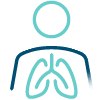Learn About a Heart Failure Treatment Option
Receiving a heart failure diagnosis can feel overwhelming. Help is available. See what treatment options may be available for you.
Heart failure is a long-term condition in which the heart muscle can’t pump enough oxygen-rich blood to meet your body’s needs.
Signs and symptoms of heart failure can include:
Swelling of the feet, ankles and legs

Shortness of breath

Weight gain
Feeling overly tired

Heart failure is a progressive condition, which means the heart gets weaker over time. It’s often called a “silent progression” because you may not notice the signs of worsening disease. The classes of heart failure are:
No symptoms or limitations to physical activity.

Slight limitations of physical activity. Comfortable at rest. Ordinary physical activity results in feeling tired and having shortness of breath.

Significant limitations such as shortness of breath and exhaustion from walking in even mild physical activity. Comfortable only at rest.


Watch this video to learn more about heart failure, ways to manage it and possible treatment options.
Read Frequently Asked Questions About Pulmonary Artery Pressure Monitoring.



MAT-2100729 v11.0
Stay Connected